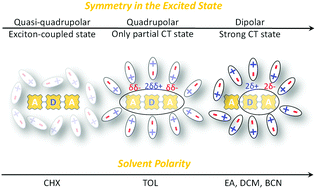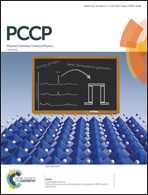Symmetry-breaking charge transfer in the excited state of directly linked push–pull porphyrin arrays†
Abstract
Herein, we revealed a symmetry-breaking charge transfer (SBCT) process in the excited state of a directly linked push–pull porphyrin dyad (AD) and triad (ADA) via spectroscopic measurements including steady-state absorption and fluorescence, time-resolved fluorescence (TRF), femtosecond transient absorption (fs-TA), and time-resolved infrared (TRIR) measurements. Unprecedented broad fluorescence spectra were observed for porphyrin arrays in polar solvents; these were attributed to the existence of a charge transfer state as evidenced by the TRF measurements. TA measurements also revealed emerging features of a CT state for AD and ADA in polar solvents. These dynamics were also confirmed via TRIR measurements, which provided further information on the solvation and structural relaxation processes of the SBCT process. This is the first observation of an SBCT process in porphyrin arrays, providing fundamental understanding of the strongly coupled porphyrin arrays. Thus, the results of this study reveal the potential of the porphyrin arrays in relevant applications requiring SBCT.



 Please wait while we load your content...
Please wait while we load your content...